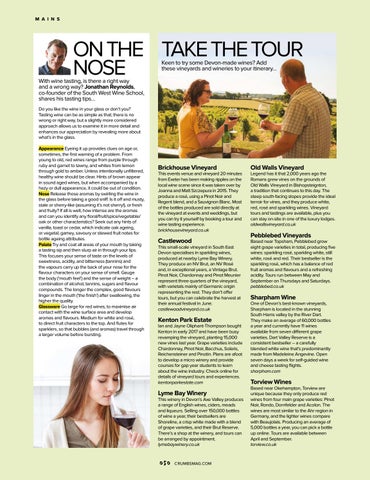M A I N S
ON THE TAKE THE TOUR NOSE Keen to try some Devon-made wines? Add these vineyards and wineries to your itinerary…
With wine tasting, is there a right way and a wrong way? Jonathan Reynolds, co-founder of the South West Wine School, shares his tasting tips… Do you like the wine in your glass or don’t you? Tasting wine can be as simple as that; there is no wrong or right way, but a slightly more considered approach allows us to examine it in more detail and enhances our appreciation by revealing more about what’s in the glass.
Appearance Eyeing it up provides clues on age or, sometimes, the first warning of a problem. From young to old, red wines range from purple through ruby and garnet to tawny, and whites from lemon through gold to amber. Unless intentionally unfiltered, healthy wine should be clear. Hints of brown appear in sound aged wines, but when accompanied by a hazy or dull appearance, it could be out of condition. Nose Release those aromas by swirling the wine in the glass before taking a good sniff. Is it off and musty, stale or sherry-like (assuming it’s not sherry!), or fresh and fruity? If all is well, how intense are the aromas and can you identify any floral/fruit/spice/vegetable/ oak or other characteristics? Seek out any hints of vanilla, toast or cedar, which indicate oak ageing, or vegetal, gamey, savoury or stewed fruit notes for bottle ageing attributes. Palate Try and coat all areas of your mouth by taking a tasting sip and then slurp air in through your lips. This focuses your sense of taste on the levels of sweetness, acidity, and bitterness (tannins) and the vapours carry up the back of your nose for the flavour characters on your sense of smell. Gauge the body (‘mouth feel’) and the sense of weight – a combination of alcohol, tannins, sugars and flavour compounds. The longer the complex, good flavours linger in the mouth (‘the finish’) after swallowing, the higher the quality. Glassware Go large for red wines, to maximise air contact with the wine surface area and develop aromas and flavours. Medium for white and rosé, to direct fruit characters to the top. And flutes for sparklers, so that bubbles (and aromas) travel through a larger volume before bursting.
Brickhouse Vineyard
This events venue and vineyard 20 minutes from Exeter has been making ripples on the local wine scene since it was taken over by Joanna and Matt Szczepura in 2015. They produce a rosé, using a Pinot Noir and Regent blend, and a Sauvignon Blanc. Most of the bottles produced are sold directly at the vineyard at events and weddings, but you can try it yourself by booking a tour and wine tasting experience. brickhousevineyard.co.uk
Castlewood
This small-scale vineyard in South East Devon specialises in sparkling wines, produced at nearby Lyme Bay Winery. They produce an NV Brut, an NV Rosé and, in exceptional years, a Vintage Brut. Pinot Noir, Chardonnay and Pinot Meunier represent three quarters of the vineyard, with varietals mainly of Germanic origin representing the rest. They don’t offer tours, but you can celebrate the harvest at their annual festival in June. castlewoodvineyard.co.uk
Kenton Park Estate
Ian and Jayne Oliphant-Thompson bought Kenton in early 2017 and have been busy revamping the vineyard, planting 15,000 new vines last year. Grape varieties include Chardonnay, Pinot Noir, Bacchus, Solaris, Reichensteiner and Pinotin. Plans are afoot to develop a micro winery and provide courses for gap year students to learn about the wine industry. Check online for details of vineyard tours and experiences. kentonparkestate.com
Lyme Bay Winery
This winery in Devon’s Axe Valley produces a range of English wines, ciders, meads and liqueurs. Selling over 150,000 bottles of wine a year, their bestsellers are Shoreline, a crisp white made with a blend of grape varieties, and their Brut Reserve. There’s a shop at the winery, and tours can be arranged by appointment. lymebaywinery.co.uk
050
CRUMBSMAG.COM
Old Walls Vineyard
Legend has it that 2,000 years ago the Romans grew vines on the grounds of Old Walls Vineyard in Bishopsteignton, a tradition that continues to this day. The steep south-facing slopes provide the ideal terroir for vines, and they produce white, red, rosé and sparkling wines. Vineyard tours and tastings are available, plus you can stay on-site in one of the luxury lodges. oldwallsvineyard.co.uk
Pebblebed Vineyards
Based near Topsham, Pebblebed grow eight grape varieties in total, producing five wines: sparkling rosé, sparkling white, still white, rosé and red. Their bestseller is the sparkling rosé, which has a balance of red fruit aromas and flavours and a refreshing acidity. Tours run between May and September on Thursdays and Saturdays. pebblebed.co.uk
Sharpham Wine
One of Devon’s best-known vineyards, Sharpham is located in the stunning South Hams valley by the River Dart. They make an average of 60,000 bottles a year and currently have 11 wines available from seven different grape varieties. Dart Valley Reserve is a consistent bestseller – a carefully blended white wine that’s predominantly made from Madeleine Angevine. Open seven days a week for self-guided wine and cheese tasting flights. sharpham.com
Torview Wines
Based near Okehampton, Torview are unique because they only produce red wines from four main grape varieties: Pinot Noir, Rondo, Dornfelder and Acolon. The wines are most similar to the Ahr region in Germany, and the lighter wines compare with Beaujolais. Producing an average of 5,000 bottles a year, you can pick a bottle up online. Tours are available between April and September. torview.co.uk
